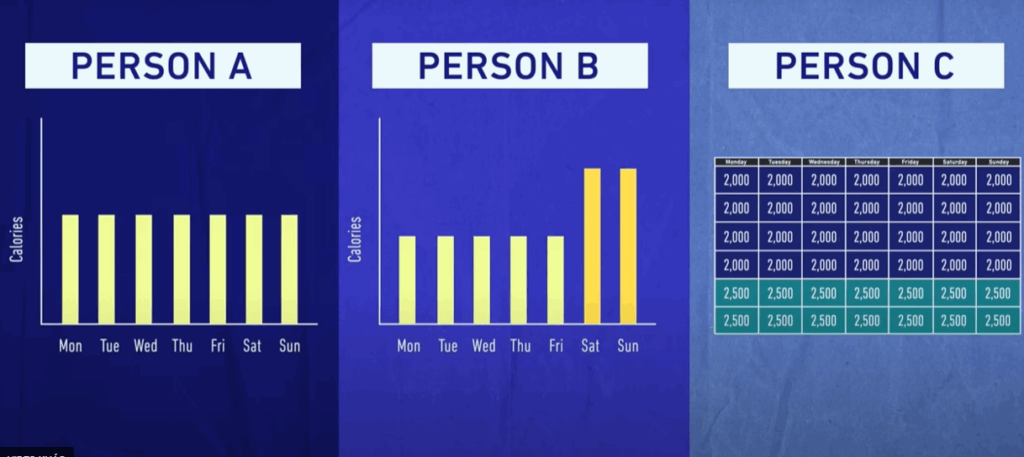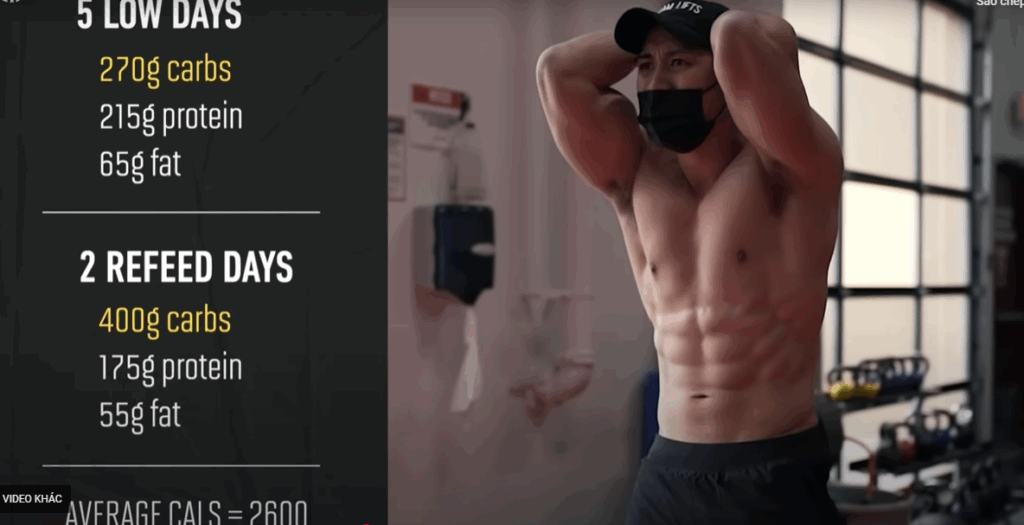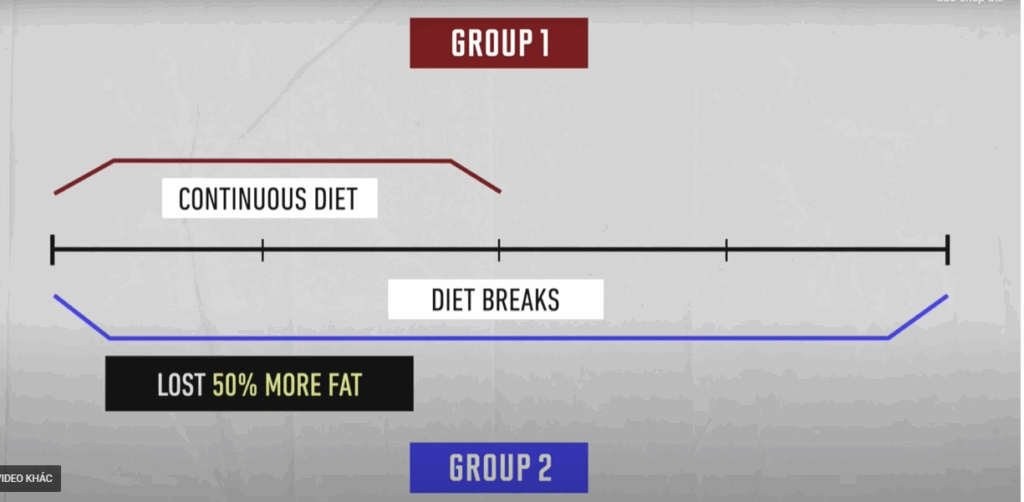The Three Dieting Styles
Let’s imagine three people—Person A, B, and C—who all have similar starting points: same training routines, body weight, and metabolic rates.
- Person A follows a straightforward, continuous diet: consuming the same 2,000 calories daily with no variation.
- Person B uses a refeed strategy, eating lower-calorie meals (1,800 calories) Monday through Friday, then increasing intake to 2,500 calories on Saturday and Sunday by primarily raising carbs.
- Person C follows Person A’s plan during the first month but takes two weeks off every six weeks to eat at maintenance (2,500 calories) before resuming their deficit. This is known as a diet break.
At a glance, their average weekly calories may be similar, but the way those calories are distributed varies dramatically. So, which approach gives the best fat loss while preserving muscle and sanity?

Why the “Calorie Deficit Is All That Matters” Isn’t the Full Story
Yes, maintaining a calorie deficit is key to fat loss. But how you structure that deficit plays a critical role in how your body responds.
Studies show that two diets with the same calorie deficit can lead to different outcomes depending on how that deficit is spread out. A slower-paced diet often helps retain more lean muscle and improve overall body composition compared to aggressive, linear approaches.
Refeeds: Strategic Carb Loading for Performance and Retention
Refeeds originated as a more disciplined alternative to cheat days. Instead of indulging without limits, a refeed increases calories—mainly through carbohydrates—for one or two days, returning the body to maintenance intake.
Why carbs? Because carbohydrates restore muscle glycogen, which supports training performance and may blunt metabolic adaptation. For full glycogen replenishment in depleted lifters, you may need around 10g of carbs per kilogram of body weight. For an 80kg (176lb) individual, that’s about 800g of carbs—hard to fit in a single day. That’s why two-day refeeds may be more practical and effective than a single high-carb blowout.
In fact, this is how many coaches program refeed days: maintain a calorie deficit five days per week, then increase carb intake for two consecutive days leading into a heavy training session. This not only helps preserve strength and fullness but makes the dieting process feel less brutal.
Refeeds in Action: The Science We Have
Until recently, most of the support for refeeds came from anecdotal evidence. But in 2020, researchers led by Dr. Bill Campbell conducted a controlled study with resistance-trained men and women. One group followed a continuous calorie deficit. The other used two refeed days each week at maintenance.
The results? Both groups lost the same amount of fat, but the refeed group preserved more lean muscle and experienced less decline in resting metabolic rate. This suggests that refeeds can help maintain muscle and support metabolism during cutting phases, even if they don’t directly accelerate fat loss.

Diet Breaks: Resetting Physiology and Psychology
Unlike refeeds, which last one or two days, diet breaks usually extend for 1–2 weeks and aim to restore both physiological and mental balance.
Bodybuilding coaches have been using diet breaks for years, especially during longer cuts. These pauses provide a mental refresh and reduce the psychological strain of chronic restriction. But they may offer more than that.
One pivotal 2017 study took two groups of overweight men. One group dieted continuously for 16 weeks. The other followed an intermittent schedule: two weeks in a calorie deficit followed by two weeks at maintenance, repeating this pattern over 30 weeks. Although the second group’s diet took nearly twice as long, they lost 50% more fat and preserved metabolism significantly better.
Even more impressive, during a six-month follow-up, the diet break group maintained their fat loss more successfully than the continuous dieters. The researchers theorized that this group became more skilled at eating at maintenance—giving them a smoother transition post-diet.
But What About Fit, Lean Individuals?
More recent research has looked at whether these same benefits apply to leaner, well-trained populations. A 2021 study had trained subjects use diet breaks in a similar fashion. The results showed no significant differences in fat loss, lean mass retention, or metabolism compared to continuous dieting.
However, there was a bright side. The diet break group reported less hunger, greater satisfaction, and better adherence to their diets. While the physiological benefits may have been muted, the psychological edge was real—and for long-term success, that’s a crucial factor.
So, Which Strategy Wins?
Here’s the breakdown based on current research and coaching experience:
- Continuous Dieting
- Pros: Simple, structured
- Cons: May lead to higher muscle loss, greater metabolic slowdown, and lower adherence
- Best for: Short-term cuts or individuals who need simplicity
- Refeeds
- Pros: Better muscle retention, improved training performance, easier psychologically
- Cons: No significant fat loss advantage unless managed carefully
- Best for: Lean individuals in strength-based training
- Diet Breaks
- Pros: Improved fat loss and metabolic preservation (especially in overweight subjects), better long-term adherence
- Cons: Takes longer overall
- Best for: Long-term fat loss, especially for those with more weight to lose

The Takeaway: Personalize and Plan Ahead
If you’re dieting for a special event like a photoshoot or competition, you might not have the luxury of taking extended breaks. But if time allows, building in refeeds or diet breaks can make the process more effective and sustainable.
Here’s what I recommend as a coach:
- Use 48-hour refeeds once or twice a week if you’re relatively lean and strength training regularly.
- Consider a 2-week diet break every 6–8 weeks if you’re in a prolonged fat loss phase—especially if you’re starting with more body fat.
- Above all, remember that slower, smarter fat loss tends to win over crash diets in both health and appearance.
By understanding the nuances of how our body responds to different dieting strategies, we can train and eat in a way that doesn’t just burn fat—but preserves performance, muscle, and motivation along the way.



